
Back Exposició Internacional de Barcelona Catalan Exposicion International de Barcelona Danish Exposició Internacional de Barcelona German Exposición Internacional de Barcelona (1929) Spanish Barcelonan maailmannäyttely (1929) Finnish Exposition internationale de 1929 French Exposición Internacional de Barcelona de 1929 Galician התערוכה העולמית של ברצלונה (1929) HE Expo 1929 Italian バルセロナ万国博覧会 (1929年) Japanese
| 1929 Barcelona | |
|---|---|
 Poster featuring a man wearing 16th century costume with the coats of arms of Spanish Kingdoms | |
| Overview | |
| BIE-class | Universal exposition |
| Category | Historical Expo |
| Name | Exposición General d'España (section: Exposición Internacional de Barcelona) |
| Area | 118 hectares (290 acres) |
| Participant(s) | |
| Countries | 20 |
| Location | |
| Country | Spain |
| City | Barcelona |
| Venue | Montjuïc |
| Coordinates | 41°22′14″N 2°09′00″E / 41.37056°N 2.15000°E |
| Timeline | |
| Opening | 20 May 1929 |
| Closure | 30 January 1930 |
| Universal expositions | |
| Previous | Panama–Pacific International Exposition in San Francisco |
| Next | Century of Progress in Chicago |
| Simultaneous | |
| Universal | Ibero-American Exposition of 1929 in Sevilla |
The 1929 Barcelona International Exposition (also 1929 Barcelona Universal Exposition, or Expo 1929, officially in Spanish: Exposición Internacional de Barcelona 1929 was the second World Fair to be held in Barcelona, the first one being in 1888. It took place from 20 May 1929 to 15 January 1930 in Barcelona, Spain.[1] It was held on Montjuïc, the hill overlooking the harbor, southwest of the city center, and covered an area of 118 hectares (291.58 acres) at an estimated cost of 130 million pesetas ($25,083,921 in United States dollars).[1] Twenty European nations participated in the fair, including Germany, Britain, Belgium, Denmark, France, Hungary, Italy, Norway, Romania and Switzerland. In addition, private organizations from the United States and Japan participated.[1] Hispanic American countries as well as Brazil, Portugal and the United States were represented in the Ibero-American section in Sevilla.
The previous 1888 Barcelona Universal Exposition had led to a great advance in the city's economic, architectural and technological growth and development, including the reconstruction of the Parc de la Ciutadella, the city's main public park. A new exposition was proposed to highlight the city's further technological progress and increase awareness abroad of modern Catalan industry. This new exhibition required the urban planning of Montjuïc and its adjacent areas and the renovation of public spaces, principally Plaça d'Espanya.
The exposition called for a great deal of urban development within the city,[2] and became a testing-ground for the new architectural styles developed in the early 20th century. At a local level, this meant the consolidation of Noucentisme, a classical style that replaced the Modernisme (in the same vein as Glasgow Style / Art Nouveau / Jugendstil, etc.) predominating in Catalonia at the turn of the 20th century. Furthermore, it marked the arrival in Spain of international avant-garde tendencies, especially rationalism, as seen in the design of the Barcelona Pavilion, created by German Bauhaus architect Ludwig Mies van der Rohe.[2] The Exposition also allowed for the erection of several emblematic buildings and structures, including the Palau Nacional de Catalunya,[2] the Font màgica de Montjuïc,[2] the Teatre Grec,[2] Poble Espanyol, and the Estadi Olímpic.[2]
- ^ a b c "Barcelone 1929" (PDF) (in French). Archived (PDF) from the original on 27 September 2007. Retrieved 27 September 2009.
- ^ a b c d e f Francesc-Xavier Mingorance i Ricart. "La Exposición Internacional de Barcelona de 1929" (in Spanish). Archived from the original on 2 October 2009. Retrieved 27 September 2009.